News of the Week: Sinatra, Silver Bells, and Scotch Whisky
Frank Sinatra’s 100th
Ol’ Blue Eyes would have turned 100 tomorrow, and many people and publications are celebrating his impact on music and culture. USA Today has a list of 10 ways he changed the world; The Guardian has a list of the best songs from Sinatra’s Capitol Record years; James Kaplan has a Wall Street Journal essay on why we’ll still be listening to Sinatra decades from now; and George Will calls him the greatest American singer of all time. Last weekend CBS had an All-Star Grammy Concert to celebrate his 100 years, with performances by Lady Gaga, Tony Bennett, Harry Connick Jr., Carrie Underwood, and Adam Levine, among others; and December is Sinatra Month on Turner Classic Movies. They’re showing Sinatra movies and specials every Wednesday night for the entire month.
It’s really hard to pick my favorite Sinatra song. He recorded so many albums that I’ll be listening to the Siriusly Sinatra channel on SiriusXM and I’ll hear a song I’ve never heard before, which is amazing after listening to him for so many years. If I had to pick one? The live version of Cole Porter’s “I’ve Got You Under My Skin” with Count Basie.
Who First Sang ‘Silver Bells’? Fred Mertz!
He was no Sinatra, but the very first person to sing the classic Christmas song “Silver Bells” was Lucy and Ricky’s friend and landlord on I Love Lucy. Well, okay, it was the actor who played him, William Frawley. He sings the first part of the song (with his own lyrics) in the 1951 movie, The Lemon Drop Kid, where the song made its debut:
Most of the song was sung by Bob Hope and Marilyn Maxwell, but it’s a cool little piece of trivia that Frawley actually started it. It’s such a classic song that it seems like it has been around a lot longer than the 1950s.
The Lemon Drop Kid is a fun movie, by the way. It’s one of those movies that doesn’t get mentioned enough as a Christmas movie.
RIP, Robert Loggia
A lot has already been written about the veteran actor, who passed away last week at the age of 85. He was fantastic in everything he did, from his roles in TV shows like T.H.E. Cat and Mancuso, FBI to dancing on the keys with Tom Hanks in the movie Big. He also did a TV commercial many years ago that is still one of my favorites:
I remember seeing it for the first time and thinking, What the hell? Why is Robert Loggia doing an orange juice commercial? It’s one of the few times I’ve laughed out loud at a commercial because it’s so clever and perfect.
Playboy’s Final Nude Issue Cover Girl Is …
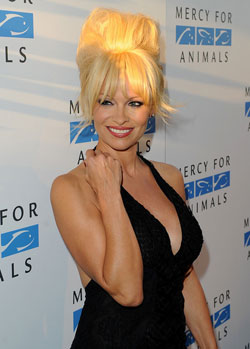
… Betty White! I know, I was surprised too!
All right, the woman who will grace the cover of the final Playboy that will feature nude photos is actually Pamela Anderson. The January/February 2016 issue will be Anderson’s 14th time on the cover, which is a record. The issue will include an interview with Anderson conducted by James Franco along with a 12-page photo spread (with Anderson, not Franco).
We told you a while back that Playboy will stop having nude models in the print edition. That’s what the Internet is for.
For the record, the final nude centerfold in Playboy will be Kristy Garett.
Changes at Barnes & Noble
How does a brick-and-mortar bookstore survive in the age of Amazon? Maybe sell a lot more than books.
New Barnes & Noble CEO Ron Boire has a plan to change the retail chain, which has been going through some tough times the past several years facing store closings and online competition. He wants to make Barnes & Noble not just a place you can get books but also a “lifestyle brand,” a place where you can get toys, gadgets, games, and other gifts (in addition to the non-book products they already sell). Oh, and coffee and lunch too, for the Barnes & Noble locations that have cafés.
As I’ve mentioned before here, I was in a Barnes & Noble recently and saw that they’re now selling vinyl albums and turntables. Maybe that’s part of this new strategy. This could be a great thing, but I hope it doesn’t mean that some day Barnes & Noble will change into a place that sells toys and gifts and, oh yeah, we have some books too.
Ticks the Season!

As if you didn’t have enough problems to worry about with real Christmas trees, from their price to the trees drying out to having to drag them to the curb in January, here comes a new one: ticks! Seems that some of the trees from the Northeast might have some unwelcome inhabitants because of the warm weather we’ve had the past few months. Don’t spray it with insecticide though. It’s flammable. Instead, shake the tree a lot before you bring it in the house.
Now when people ask me how I can possibly prefer an artificial tree to a real one, I’ll just say, “Hey, no ticks!”
Nick Offerman Nipping at Your Nose
The Internet is filled with superlatives. It’s not enough that something is good and enjoyable, everything has to be THE BEST THING THAT HAS EVER BEEN ON THE INTERNET or THE GREATEST VIDEO YOU’VE EVER SEEN or YOU WON’T BELIEVE WHAT HAPPENS NEXT IN THIS VIDEO CLICK HERE! It has gotten to the point of being silly, inaccurate, and just plain ridiculous.
Having said that, this video might just be THE GREATEST VIDEO YOU’VE EVER SEEN. You know those Yule logs that we see on various TV stations during the Christmas season, just an endless video of a crackling fire on our screens that give our living rooms a warm glow and a sense of the holiday season? Here’s a new entry, with a twist: 45 minutes of actor Nick Offerman sitting next to the Yule log, enjoying some Lagavulin.
It’s best if you know Parks and Recreation and picture Offerman as his character Ron Swanson, deciding to just sit in his chair and stare straight ahead while drinking his single-malt Scotch whisky, waiting for his hearty steak dinner to be ready. Expand the video to full-screen and turn up the volume and leave it on while you’re wrapping gifts.
National ‘Have a Bagel’ Day
It’s today, and it shouldn’t be confused with National Bagel Day, which was February 9. I don’t know what the difference is. Maybe on National Bagel Day you can celebrate the bagel as long as you don’t actually “have” one.
How about some Christmas bagels? Here’s a recipe from the Eclectic Recipes site that turns ordinary bagels into Pizza Bagel Wreaths, with broccoli or spinach for the greenery and red peppers for the bow.
I don’t know what you can do if your kids don’t like broccoli or spinach. Maybe a little pesto? Just don’t tell them about the basil leaves.
Upcoming Events and Anniversaries
Dick Van Dyke born (December 13, 1925)
Van Dyke just turned 90 and has a new book out, Keep Moving and Other Tips and Truths About Aging.
George Washington dies (December 14, 1799)
The Saturday Evening Post has had many covers over the years focusing on our first president.
Glenn Miller disappears (December 15, 1944)

The Battle of the Bulge starts (December 16, 1944)
The battle on the Western Front in Europe lasted until January 25, 1945.
A Christmas Carol is published (December 17, 1843)
Classic Covers: Music of the Sixties
The Beatles – photo by John Zimmerman
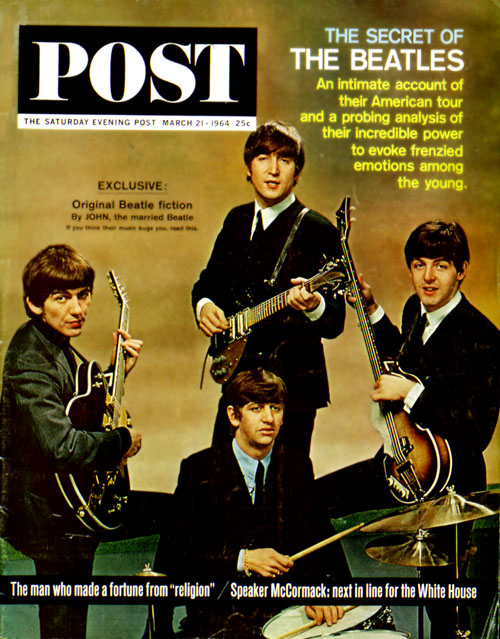
Photographer John Zimmerman was one of the best. His lens caught famous politicians and newsmakers, and even strange new groups from Britain. But this 1964 photo of the Fab Four is a classic. The cover promised “a probing analysis of their incredible power to evoke frenzied emotions among the young.” Yeah, Yeah, Yeah. What do you expect from stuffy old editors who worked Eight Days a Week? To simplify: the Beatles just made us feel Glad All Over. Okay, I’ll stop now.
Sonny and Cher – photo by Jerry Schatzberg
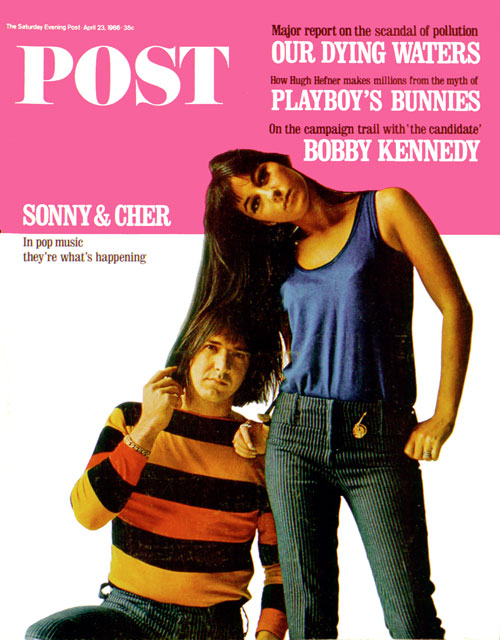
Another classic! Cher is looking hot and Sonny is looking, well, not the least bit Republican. Always up-to-date on the latest lingo, the editors informed us that Sonny and Cher were “what’s happening, baby”. Cher was known for her mod fashions, but here’s a description of Sonny backstage at the Hollywood Palladium: “Although the musicians were wearing tuxedos, Sonny had on a yellow turtleneck sweater, a white, double-breasted pirates’ jacket with wide lapels, epaulets and yellow puffs for buttons. His trousers were white, tight, and ornamented with a wide, silver-buckled, brown-leather belt, and black boots completed the outfit.” You can’t get more hip than that. That description, by the way, was from the author of the article, Peter Bogdanovich.
Roger Miller – photo by Maurie Rosen
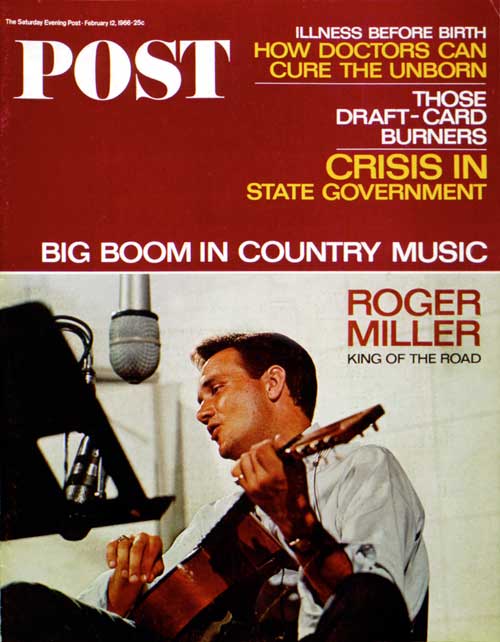
It wasn’t just rock and roll. There was a “big boom in country music”. Anybody over fifty remembers the “King of the Road”. From “Engine Engine No. 9” to wishing you had a “Do Wacka Do” (okay, you had to be there), Roger Miller was big time. What is country music? “It’s soul in a rhinestone suit”, the article said, “honesty with amplifiers, a new ‘uptown’ sound that city folks like—and it’s back in the big time again.” Remember “A White Sport Coat” by Marty Robbins? The Carter Family? Sonny James? This was “that new sound from Nashville”. But no one could do “You Can’t Roller Skate in a Buffalo Herd” like Roger Miller.
The Mamas and the Papas – photo by Dan Wynn
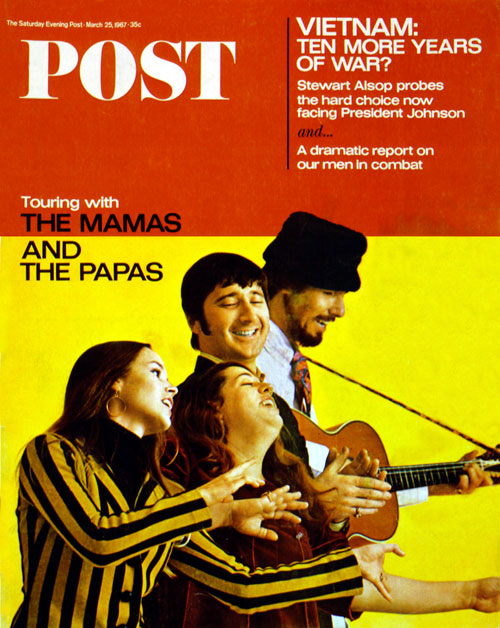
“Monday, Monday,” “Calfornia Dreamin’,” “I Saw Her Again” – the hits just kept coming for the Mamas and the Papas, proving they weren’t just hippies – they were hippies with talent. But they were on the wild side. A guy in one audience stood up and shouted, “Cass, Cass, I love you.” Cass “peered into the audience from the footlights. ‘Dynamite! Where are you staying?’” The article by William Kloman stated that once “the Mamas and the Papas instigated a riot, mainly to test their theory that it could be done scientifically. John got a black eye for his efforts, and they have since tried to keep their audiences under control.” Mama Cass (whose voice on “Dream a Little Dream of Me” I will always remember) died of a heart attack in 1974, John passed away in 2001 and Denny in 2007. Happily, lovely Michelle is still with us.
Frank and Nancy Sinatra – Supremes photo
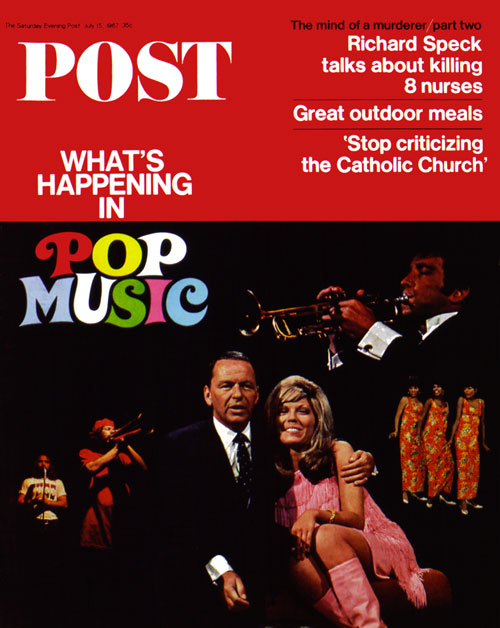
“It has been 15 years now since rock ‘n roll was laughed off as just another fad,” the Alfred G. Aronowitz article states. “Frank Sinatra called it ‘the martial music of every sideburned deliquent on the face of the earth.’ The police in Atlanta, Ga., ruled that teen-agers couldn’t dance to it without written parental consent. Roman Catholic leaders in Boston called for a boycott of it, to be enforced by a censor. And the head of the White Citizens Coucil in Alabama saw it as part of a Negro plot to ‘mongrelize America.’” Welcome to the 60’s, folks. The diversity in music was a sign of the jumbled times: Herb Alpert, The Supremes, The Byrds, Simon and Garfunkel, Petula Clark. 27-year-old Nancy Sinatra, “has already collected three gold singles, which is two more than Frank Sinatra ever got in his entire 26-year career.” And then Frank and his little girl have a smash love duet, “Something Stupid.” Something Crazy was going on.
Bob Dylan – photo by Elliott Landy
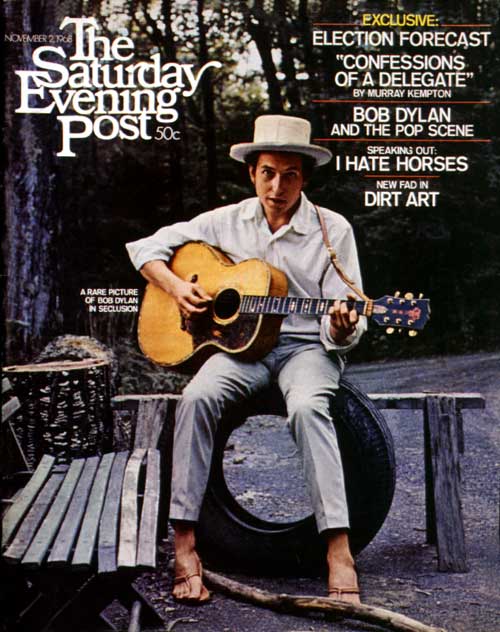
Okay, I confess: once, hearing a guy on a radio program dedicate a Bob Dylan song to our troops, my response was “haven’t they suffered enough?” Not a fan of the voice – sorry. This 1968 article covered “the royal family” of pop. From Hendrix to Buck Owens, Joplin to Merle Haggard, B.B. King to the Beach Boys. And oh yes, the Stones, Simon & Garfunkel and Johnny Cash. Then, “Enter the King, Bob Dylan”. Author Alfred G. Aronowitz makes Dylan’s lyrics sound almost biblical, “….the mysterious Ballad of Frankie Lee and Judas Priest” he says, is “a parable of friendship and temptation.” And “the moral of one of his songs, he recites, is that no man should be where he does not belong, that each man should help his neighbor, that no one should envy his neighbor’s lot.” But I can’t argue about the unending beauty of “Blowin’ in the Wind,” which became something of a civil rights anthem. Indeed, how many roads must a man walk down…
Paul Anka: Doing It His Way
Singer-songwriter Paul Anka remembers the first check he received after his recording of “Diana” soared to the top of the pop charts. The amount was $300, modest even by 1957 standards, but “it seemed like a lot of money to a kid coming off a paper route in Canada,” says Anka, who was 16 at the time. Unlike many one-hit wonders whose success was short-lived in the early days of rock and roll, Anka had the savvy and talent to stay ahead of the trends. The music he wrote soon evolved from sock-hop ballads like “Puppy Love” to big-band standards like “My Way,” created for his mentor and close pal Frank Sinatra.
“Frank and Sammy [Davis, Jr.] looked after me, watched over me, and allowed me into their circle,” he says of the legendary entertainers. The “circle” was Sinatra’s famed Rat Pack, and members included Dean Martin, Peter Lawford, and Joey Bishop. Sinatra gave them all nicknames, which were embroidered on the robes they wore when they lounged around the saunas and pools at the Las Vegas hotels where they performed. Anka, decades younger than the rest of the Pack, emerged as The Kid. The name stuck, although “as I got older and after I wrote ‘My Way,’ the mentoring thing became more of a friendship,” he says.
With an active concert schedule and a new CD in the works, Anka doesn’t dwell on nostalgia, although a couple of current projects have him rummaging through his files and pulling out photos, clippings, and programs from the past. If everything goes according to plan, 2009 is going to be a big year. His autobiography, still untitled, is scheduled for an autumn release, and he’s in preliminary talks about a Broadway show based on his 50-year career.
At age 67, The Kid is on a sentimental journey, recalling the times he traveled with Elvis, hung out with Buddy Holly, popped up on American Bandstand, and wrote a theme song for Johnny Carson. And then there was Ole Blue Eyes….
We’ll begin there.
The Post has uncovered an interesting photo of you, Frank Sinatra, and a monkey. Is there a story behind the picture?
Actually, it was an orangutan. We were in Vegas, and Frank’s friends were throwing a birthday party for him. I remember thinking, What do you give to a guy who has everything? So I went to the circus that was playing at a nearby hotel, and I said, ‘Let me borrow the orangutan.’ It was fitting because back then the atmosphere in Las Vegas was all about the prank. I marched into the party with the orangutan and gave it to Frank. Little did I know that in those days he was wearing a very bad toupee, and [in photos taken that night] the monkey’s hair looks better than Frank’s.
Of the more than 900 songs that you’ve created, “My Way” may be most memorable. What motivated you to write the words that became Sinatra’s signature signoff?
We were at a dinner in Florida when he announced his plan to retire. The Rat Pack had dissipated and he was tired. He said he would make one more album, and then he wanted out. That moved me to go home, imagine myself in his place, and write what would be the retiring song for someone who was the premier artist of all time. I used to do everything on the typewriter — I could type 60 to 65 words a minute — and so I just rattled away from one a.m. until I finished it around five. The song became a turning point for both of us. I remember I was in New York when he called me from the studio in Los Angeles and played it for me for the first time over the phone.
Let’s talk about the early days, the ’50s and ’60s, when you toured with some of the pioneers of rock and roll. What was it like to travel with these great artists — many of them African-American — at a time when some venues didn’t welcome people of color?
I remember that period in great detail. Coming from Canada, it was very difficult for me to understand segregation. I was close to the Platters, Chuck Berry, Fats Domino, and the others. Consequently, I was taken aback by it. We were close because of the music, but the situation drew us even closer. I remember refusing to eat at places that wouldn’t serve them. I was part of the team and we were very protective of each other. It was a time of great camaraderie.
How did your parents feel about their son going into show business at such a young age? Did they encourage you?
Things were different than they are now. A lot of parents today are sophisticated and start training their kids at age four or five because with shows like American Idol, they know what’s at the end of the rainbow. They understand the possibilities. But that wasn’t the case for us. Television started at five in the afternoon in Canada, and the programming was limited. People really didn’t have their arms around the music yet. My parents were dealing with the unknown — and a kid who was focused and aggressive about what he wanted. They were very concerned when I borrowed some money and went off to New York. Then I called them and said, “Come on down and sign my contract.” They were dazzled by it … and so was I.
You’re working on your autobiography now, piecing together five decades of history. What’s it like to go back in time and recall all that you’ve seen and done?
It’s been cathartic and sentimental. I’ve kept all my memorabilia…all the letters, articles, itineraries, and pictures. I have 50 years’ worth of material, so it’s really a process of editing out what I feel is not important or what I’m not willing to reveal. The memories come back, maybe not the details, but the meat is there when I look at the pictures and read the letters. I can remember what was going on and the people I was meeting.
And now there’s the possibility of a Broadway show…. Do you have a performer in mind to play Paul Anka as a teenager?
Yeah, I like the young kid who was on American Idol [David Archuleta], but there would have to be someone else. My real dream stroke is Robert Downey, Jr. His energy and capabilities are what I envision. That would be the coup of the century.
The music you’ve created over the decades is so varied that it can’t be tucked into a pigeonhole or given a label. How do you continue to stay up on the trends? When you’re in the car with the radio on, what do you like to listen to?
A lot of everything. There’s so much good stuff out there; my taste is eclectic. I listen to Madonna, Elton John, Yo-Yo Ma, Alicia Keys, Tim McGraw…. I have to be aware of what’s going on. I’m always learning something. I can’t come from a limited point of view of not embracing all music. I think that’s a mistake. Some artists are pretty highfalutin about what they do. That’s not me. I like country music a lot…I love the lyrics; I think country is the purest American music; that and jazz. As a musician I get a little something out of all of them.
Obviously you’re not thinking about retiring. Your last couple of albums did well, and you’re headed into the studio for another. Will it be classic Anka or new material?
I’m coming off of the success of Rock Swings [album released in 2005]. That went gold in many markets and gathered a new audience for me. I’m playing to 20,000 and 30,000 people in some cases, and 30 to 40 percent are under age 35. A lot of that is because of Rock Swings. I don’t know if I want to stay on that page, because I’ve done it. The next album may be newly written material from my observations at this stage of my life. My last album took me at least nine months to finish. You can’t rush something like that. Everything looks like it will happen in 2009.